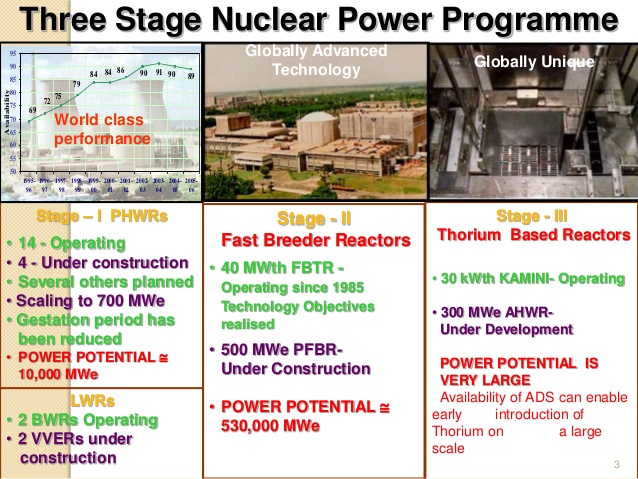India’s three-stage nuclear power programme was formulated by Homi Bhabha in the 1950s to secure the country’s long-term energy independence, through the use of uranium and thorium reserves found in the monazite sands of coastal regions of South India.
India has been pursuing the following 3-stage Nuclear Power Programme :
- Stage 1 : Pressurised Heavy Water Reactors (PHWRs)
- The first stage comprises setting up of Pressurised Heavy Water Reactors (PHWRs) and associated fuel cycle facilities.
- PHWRs use natural uranium as fuel and heavy water as moderator and coolant
- The first stage is already in commercial domain.
- The Nuclear Power Corporation of India Ltd. (NPCIL), a public sector undertaking of DAE, is responsible for the design, construction and operation of nuclear power reactors
- Stage 2 : Fast Breeder Reactors (FBRs)
- The second stage envisages setting up of Fast Breeder Reactors (FBRs) backed by reprocessing plants and plutonium-based fuel fabrication plants.
- A breeder reactor is one that breeds more material for a nuclear fission reaction than it consumes.
- Plutonium is produced by irradiation of uranium-238
- The prototype FBR is fuelled by a blend of plutonium and uranium oxide, called MOX fuel.
- The Fast Breeder Programme is in the technology demonstration stage.
- A new public sector undertaking Bharatiya Nabhikiya Vidyut Nigam (BHAVINI) of DAE is implementing this project which is expected to add 500 MWe to the Southern grid by the year 2017
- The tariff of electricity produced from PFBR is comparable with that of other conventional electricity generating technologies like coal based thermal power stations in the region
- Stage 3 : Advanced Heavy Water Reactor (AHWR)
- The third stage is based on the thorium-uranium-233 cycle.
- Uranium-233 is obtained by irradiation of thorium
- India has one of the largest reserves of thorium
- The ongoing development of 300 MWe Advanced Heavy Water Reactor (AHWR) at BARC aims at developing expertise for thorium utilization and demonstrating advanced safety concepts.
- Thorium-based systems can be set up on commercial scale only after a large capacity based on fast breeder reactors, is built up.
Objective of 3 Stage program:
- The ultimate focus of the programme is on enabling the thorium reserves of India to be utilized in meeting the country’s energy requirements.
- Thorium is particularly attractive for India, as it has only around 1–2% of the global uranium reserves, but one of the largest shares of global thorium reserves.
- However, at present thorium is not economically viable because global uranium prices are much lower.
- The Indo-US Nuclear Deal and the NSG waiver, which ended more than three decades of international isolation of the Indian civil nuclear programme, have created many hitherto unexplored alternatives for the success of the three-stage nuclear power programme.
- Thorium itself is not a fissile material, and thus cannot undergo fission to produce energy.
- Instead, it must be transmuted to uranium-233 in a reactor fuelled by other fissile materials [plutonium-239 or uranium-235].
- The first two stages, natural uranium-fuelled heavy water reactors and plutonium-fuelled fast breeder reactors, are intended to generate sufficient fissile material from India’s limited uranium resources, so that all its vast thorium reserves can be fully utilized in the third stage of thermal breeder reactors.
